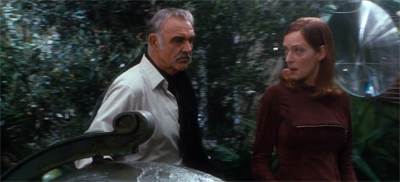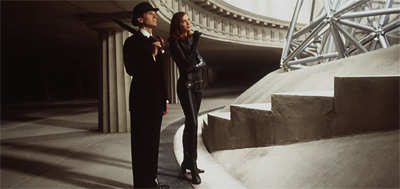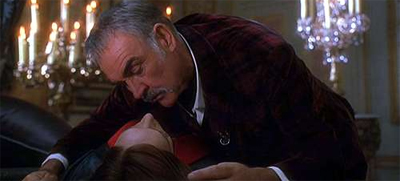This Saturday, I’ll be discussing The Avengers on The 250, the weekly podcast that I co-host discussing the IMDb’s Top 250 Movies of All-Time. However, I had some thoughts on the film that I wanted to jot down first.
This is not a defense of The Avengers.
There is no defending The Avengers. The film is legendary and spectacular failure. There is no belated reclamation project under way, no attempt to salvage its reputation twenty-odd years after it landed in a smoking crater. The film’s production history is storied, and disastrous. The film was subject to internal power struggles within Warner Brothers, falling between a changing of the guard and sabotaged at a test screening with a hostile audience. Twenty-five minutes of the film were unceremoniously cut out, and the score was radically rewritten. The result is monstrous.

More than that, there is little to indicate that The Avengers could ever have been a good film, even its pristine and uncut state. The flaws with the movie run deeper than those definable absences. The two leads share no chemistry, despite the fact that the film hinges on their dynamic. The plot is complete nonsense, haunted by the shadow of countless rewrites rather than simply lost in the edit. The film’s surrealism is halfhearted rather than committed, flirting with deranged brilliance but always landing somewhere on the uncomfortable side of mere camp. The Avengers is bad.
And, yet, in spite of all that, something interesting beats at the heart of The Avengers. Part of this is a result of the movie’s intrinsic late-nineties-ness, the way that it captures the mood of that moment. It is very much a post-Cold War story, its stakes framed in environmental terms that reflect the anxieties of the cultural moment. (Remember when mankind healed the hole in the ozone layer?) Similarly, the movie’s flirtation with the surreal and the notion of collapsing reality echoes (better) films like The Truman Show or The Matrix or Dark City or eXistenz or Fight Club.

However, the most interesting aspect of the film remains its central performance from Sean Connery. At the time, Connery had just successfully reinvented himself as a box office draw in the late nineties, building off the success of his collaboration with Michael Bay and Nicolas Cage in The Rock. The late nineties were were busy time for Connery, with projects including Entrapment, Playing by Heart and Finding Forrester. The actor was undergoing what might be characterised today as a “Conneraissance.”
In the middle of that “Conneraissance”, there is something rather strange about The Avengers, in large part because it’s a performance that exists in dialogue with his most iconic role. Of course, there’s no getting around Connery’s time as James Bond. The Rock rather heavily implies that Connery’s character was a version of James Bond arrested around the time of Diamonds are Forever. However, The Avengers goes one step further. The Avengers doesn’t just cast Sean Connery as a Bond villain. The Avengers casts Sean Connery as James Bond as a Bond villain.

There are obvious parallels between The Avengers and the James Bond franchise. Both are British institutions rooted in the sixties, focusing on debonair gentlemen spies and beautiful female companions. There are even several overt points of overlap. Honour Blackman was both the first female lead of The Avengers and an iconic Bond girl in Goldfinger. Diana Rigg succeeded Honour Blackman as the female lead in The Avengers and then played an iconic Bond girl in On Her Majesty’s Secret Service. Patrick Macnee had to wait until View to a Kill to crossover.
More to the point, any villain in a feature film adaptation of The Avengers was going to invite parallels to a villain in the James Bond franchise. After all, that as veyr much the cultural frame of reference for that sort of cinematic supervillain. Comic book movies had yet to really take off as action movies, outside of Richard Donner’s Superman or Tim Burton’s Batman, so any villain threatening the leaders of the free world with his weather-changing machine was going to come across as a spirtual successor to Blofeld or Scaramanga or Zorin.

However, the characterisation of August de Wynter is consciously designed to riff on the iconography of the classic Bond villain. De Wynter is an established society type, which allows him to trade witty repartee with his opponents before trading blows. De Wynter has a mostly-silent gimmick henchman played by Eddie Izzard, even if that henchman is mostly crap. De Wynter has access to science-fiction technology that allows him to hold the world ransom, like any number of classic James Bond villains. Indeed, Francisco Scaramanga was even a pseudo-environmentalist.
These tropes and conventions would have already been in the public consciousness. When The Avengers was released, the James Bond franchise was undergoing a revival with Pierce Brosnan taking up the role of the iconic secret agent. GoldenEye found the character facing off against both the challenges of the post-Cold War era and a supervillain who had weaponised a satellite to bring death from above. Even ignoring Brosnan, there were a rake of nineties parodies of the super-spy; Spy Hard!, Austin Powers, Austin Powers: The Spy Who Shagged Me.

De Wynter is recognisable as an exaggerated parody of the archetypal Bond villain. Even his interest in horticulture mirrors the obsession of Hugo Drax in Moonraker. However, the film is having a bit of fun with this. Generally speaking, James Bond films tend to exaggerate the foreign “otherness” of villains; the generic European Ernst Stavro Blofeld, the Aryan Max Zorin, the French Hugo Drax, the Germanic Auric Goldfinger, even the Caribbean Kananga. However, the beauty of de Wynter is that he is cast as a British Bond villain. Specifically, a Scottish Bond villain.
The Avengers ensures that the audience never forgets that Connery is a Scottish actor, as if that were possible given his accent and his celebrity. When de Wynter threatens the world assembly with his weather-changing technology, he does so clad in a kilt. When it comes time to add a theatrical flourish at the end of his statement, he hits a giant globe as if it were a golf ball. De Wynter is a broad caricature of Scottishness, in the same way that other Bond villains have exaggerated their own national stereotypes.

However, there is an additional edge to Connery’s performance in The Avengers. De Wynter isn’t just another stock Bond villain. There is a very tangible sense in which Connery has been asked to play Bond again. (In this context, it is worth noting that the actor filmed a video in character for Ralph Fiennes’ birthday during the production of the film.) De Wynter might have a number of obvious markers of a Bond villain, but he also shares a lot of traits with Bond himself. In a direct allusion to Goldfinger, the character is even featured playing croquet with Father at one point.
The most superficial point of comparison might be his love of sleazy wordplay. De Wynter is introduced tending to his guardian, receiving a visit from Emma Peel. “Take India,” he advises her. “You can have a good ten inches overnight there. You know, one should never fear being wet.” Connery is having a great deal of fun with this sort of dialogue, and his delivery inevitably calls to mind some of his own particularly point double entendres in films like Goldfinger.

However, the comparisons become a lot more pointed when it comes to De Wynter’s strange fascination with Peel. The Avengers is a deeply creepy movie, in ways that the script never seems quite able to process. There is a sense in which the movie’s approach to Peel is just casual misogyny, similar to the manner in which Mission: Impossible II treats the character of Nyah Hall. Certainly, the way that the camera approaches Uma Thurman in that iconic catsuit suggests that the audience is intended to leer over her as much as de Wynter does.
Accepting that this may be an overly generous interpretation of general perviness on the part of the film, there is something deeply uncomfortable in de Wynter’s attitude towards women that runs deeper than the sort of casual misanthropy associated with blockbuster villains. De Wynter is aggressively and horrifying fixated on Peel. In a touch that is never actually explained in the movie, a touch that makes the movie both worse and creepier, de Wynter is introduced playing a gigantic organ under a portrait of Peel. His prior relationship to her is never articulated.

At one point in the film, de Wynter has a drugged and unconscious Peel at his mercy. His intentions towards the unconscious young woman are very clear, even in the context of what was supposed to be a family-friendly mid-summer blockbuster. He dances with her, draping her over the bed. He removes a band from around her neck. He caresses her face. He leans in to kiss her, only to be interrupted by the sound of the doorbell. It is a surprisingly graphic scene in a film that is consciously aiming for camp absurdity.
Even in the realm of camp absurdity, there is something deeply uncomfortable about de Wynter’s obsession with Peel. Before the start of the film, he has somehow created a perfect duplicate of Peel. Again, the movie is pointedly abstract in terms of explaining this. Is she a robot or a clone? Why Peel of all people? Given how de Wynter attempted to abuse Peel, what has he done to her doppelganger? Perhaps it is a good thing that the film does not go into any depth on this, given the obvious implications.

Again, one must be careful not to construct anything that sounds too much like a defense of The Avengers. After all, these ambiguities are more likely to be a result of incompetence than of some clever artistic design. After all, there is a strange moment when Peel seems almost moved by the death of her murderous copy. Steed asks her what happened to her counterpart, and Peel responds, “Dispatched, I think. Sad, in a way.” The film never earns that “sad, in a way.” The film has never even acknowledged the idea of the duplicate Peel having a personality or autonomy.
As with the wordplay, there is a sense in which de Wynter is a dark and cynical reflection of the character of James Bond. In particular, a reflection on the character’s long-standing sexual politics. As played by Sean Connery, the iconic spy was not particularly attuned to issues like consent or choice. In Thunderball, he blackmails a nurse into sleeping with him by threatening to have her fired if she refuses. In Goldfinger, he sabotages Jill Masterson’s work in a way that leads to her murder by her employer before forcing Pussy Galore in the hay. (In the novel, she’s explicitly lesbian.)

To be fair, these criticism are hardly new, and certainly weren’t when The Avengers decided to cast a former James Bond as a would-be rapist super villain. GoldenEye made a point to call out the character as a “sexist misogynist dinosaur” and subsequent films in the franchise have (to varying degrees) grappled with issues such as the sexual agency of the female lead. Austin Powers made a point to emphasise how out of touch its lead character was with contemporary culture, albeit in a broadly affectionate way.
That said, there is a lot of power in using Sean Connery to make this point, in having Sean Connery indulge in the sort of strong-arm sexual aggression long associated with James Bond, while casting him explicitly as the villain and making these scenes as creepy as possible. While The Avengers arguably objectifies Uma Thurman as readily as de Wynter objectifies Peel, with pans over her catsuit-clad body, there’s no denying that the sequences with de Wynter are meant to be unsettling rather than titilating; Peels eyes open, but her head bobs helplessly. It’s horrifying.

The Avengers is a bad film, but it is often bad in interesting ways. Its decision to cast Sean Connery as James Bond as a James Bond villain is flawed and clumsy, even by the standards of the film, but it is an interesting and provocative choice.
Filed under: On Second Thought | Tagged: james bond, sean connery, the avengers |




















Leave a comment